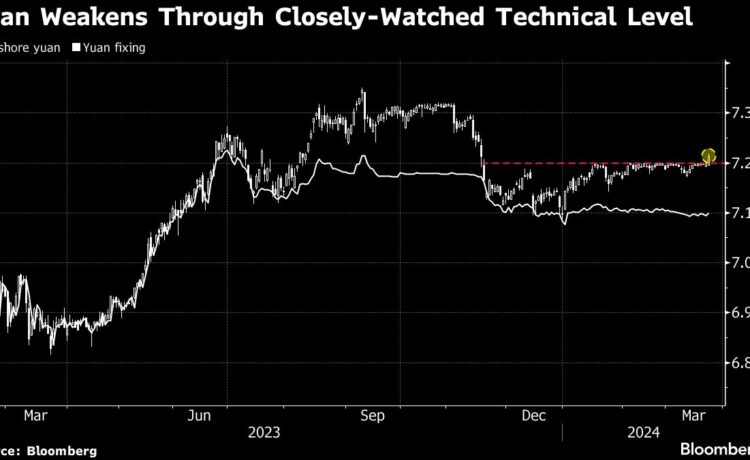(Bloomberg) — Chinese authorities have kept the yuan in a vise-like grip for four months, but now signs are emerging that they are ready to allow the currency to weaken.
Most Read from Bloomberg
The onshore yuan on Friday slipped beyond the 7.20 per dollar line that had mostly held since November. The decline sent ripple effects across Asian markets, accelerating losses in some regional currencies and weighing on sentiment toward China-linked assets.
The catalyst for the yuan’s slide was the People’s Bank of China’s decision to lower its daily reference rate for the managed currency by the most since early February. State banks also refrained from selling large amounts of dollars at the open, according to traders.
The move lower in the yuan may have been “triggered by the weaker fix,” said Fiona Lim, a senior foreign-exchange strategist at Maybank in Singapore. That sent a signal that the “PBOC is willing to allow some weakness in the yuan as the dollar has gained a bit of a bullish bias recently,” she said.
While the central bank has been anchoring the yuan through its daily fixings since last year, pressure has been building as the strengthening dollar weighed on Asian currencies. The PBOC faces the difficult task of trying to stimulate China’s fragile economy through monetary easing, while keeping the yuan relatively steady and preventing capital outflows.
The yuan’s decline past 7.20 came after PBOC Deputy Governor Xuan Changneng said Thursday China still has room to lower the reserve requirement ratio for banks and boost liquidity. In the past few days, the yen also failed to get a boost from the Bank of Japan’s decision to exit its negative-interest-rate policy, a further sign of the dollar’s underlying strength.
Adding to the bearish yuan sentiment is a proposed bill being considered by US Congress that would block mutual funds from investing in some products that track Chinese stock indexes. Key Chinese equity gauges slipped more than 1% Friday.
‘Gradual Pace’
Still, further losses in the yuan would increase the prospect of additional support from the PBOC, such as state bank selling of the dollar or verbal intervention. The central bank may also tighten liquidity in offshore markets to make betting against the currency more expensive.
In at least one sign of growing yuan support, traders said China’s state banks boosted dollar sales in the onshore market Friday after the yuan weakened past 7.22 per dollar.
The “aggressive” market reaction to a weaker yuan fixing on Friday may lead to more cautious moves ahead by the authorities, said Becky Liu, head of China macro strategy at Standard Chartered Plc. The PBOC may need to step up FX management in the near term to avoid any herd behavior against the yuan, she said.
–With assistance from Qizi Sun, Ran Li, Iris Ouyang, April Ma and Tania Chen.
(Updates with more details)
Most Read from Bloomberg Businessweek
©2024 Bloomberg L.P.
















